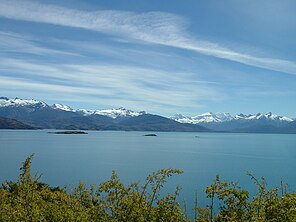| General Carrera Lake | |
|---|---|
| Buenos Aires Lake Lake Buenos Aires | |
 | |
General Carrera Lake in the Aysén Region | |
| Location | Lago Buenos Aires Department, Santa Cruz Province, Argentina / General Carrera Province, Aysén del General Carlos Ibáñez del Campo Region, Chile, in Patagonia |
| Coordinates | 46°26′15″S 71°42′54″W / 46.43750°S 71.71500°W[1] |
| Type | Moraine dammed |
| Primary inflows | Soler, Los Antiguos, Jeinemeni, Ibáñez, San Martín, Delta |
| Primary outflows | Bertrand Lake and then Baker River (Pacific Ocean) Deseado River (Atlantic Ocean) |
| Catchment area | 14,861 km2 (5,738 sq mi) |
| Basin countries | Argentina, Chile |
| Surface area | 1,850 km2 (710 sq mi) |
| Average depth | 400 m (1,300 ft)[2] |
| Max. depth | 586 m (1,923 ft) |
| Water volume | 740 km3 (180 cu mi)[3] |
| Shore length1 | 707 km (439 mi) |
| Surface elevation | 217 m (712 ft) |
| Frozen | never |
| Settlements | Chile Chico, Puerto Ingeniero Ibáñez, Puerto Guadal, Los Antiguos |
| References | [1] |
 | |
| 1 Shore length is not a well-defined measure. | |
General Carrera Lake (Chilean part, officially renamed in 1959)[4] or Lake Buenos Aires (Argentine part) is a deep lake located in Patagonia and shared by Argentina and Chile. Both names are internationally accepted, while the autochthonous name of the lake is Chelenko, which means "stormy waters" in Aonikenk.[5] Another historical name is Coluguape from Mapuche, a derivative of this name is applied to Colhué Huapí Lake after Argentine explorer Francisco Moreno reached this lake in 1876 conflating it with Coluguape (General Carrera Lake).[6]
The lake is of glacial origin and is surrounded by the Andes mountain range. The lake drains to the Pacific Ocean on the west through the Baker River. During the last glaciation the lake drained to the Atlantic through Deseado River.[6]
The weather in this area of Chile and Argentina is generally cold and humid. But the lake itself has a sunny microclimate, a weather pattern enjoyed by the few settlements along the lake, such as Puerto Guadal, Fachinal, Mallín Grande, Puerto Murta, Puerto Río Tranquilo, Puerto Sánchez, Puerto Ingeniero Ibáñez and Chile Chico in Chile, and Los Antiguos and Perito Moreno in Argentina.
The area near the coast of the lake was first inhabited by criollos and European immigrants between 1900 and 1925. In 1971 and 1991, eruptions of the Hudson Volcano severely affected the local economy, especially that of sheep farming. A car ferry operates between Puerto Ingeniero Ibáñez and Chile Chico in the Chilean sector of the lake. The lake is known as a trout and salmon fishing destination.
- ^ a b Earth Info, earth-info.nga.mil webpage: "GNS: Country Files". Archived from the original on 2012-05-04. Retrieved 2010-06-27.
- ^ carrera-buenos aires lake General Carrera-Buenos Aires Lake, on lakepedia.com
- ^ carrera-buenos aires lake General Carrera-Buenos Aires Lake, on lakepedia.com
- ^ "Ley N.º 13.375: Crea y fija los limites de los departamentos de Palena, Aysén, Coyhaique y Chile Chico y las de sus respectivas comunas-subdelegaciones". Ministerio del Interior de Chile. 1959-09-09.
- ^ Prudencio Vergara, Guillermo (2019-05-06). "Una "fiebre del oro" junto al mayor lago de la Patagonia" [A "gold fever" along the major lake in Patagonia]. El País (in Spanish). Chile Chico. Retrieved 2021-12-29.
- ^ a b Melo, Walter D.; Scordo, Facundo; Perillo, Gerardo M. E.; Píccolo, M. Cintia (2017). "Identificación del lago "Coluguape" en la cartografía histórica (1775-1898): Su vinculación con el lago Buenos aires-General Carrera y el sistema lacustre Musters-Colhue Huapi" [Identification of the "Coluguape" lake in historical cartography (1775-1898): Its connection to the Buenos Aires-General Carrera lake and Musters- Colhue Huapi lake system]. Magallania (in Spanish). 45 (1): 15–33. doi:10.4067/S0718-22442017000100015. hdl:11336/27464.

